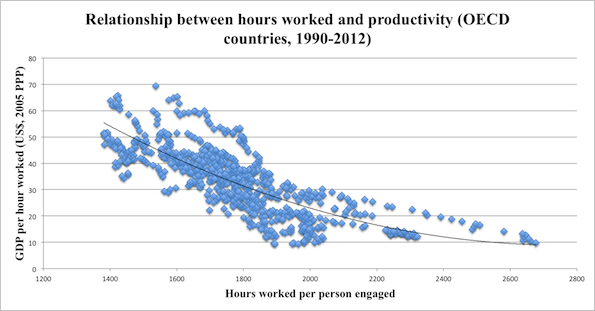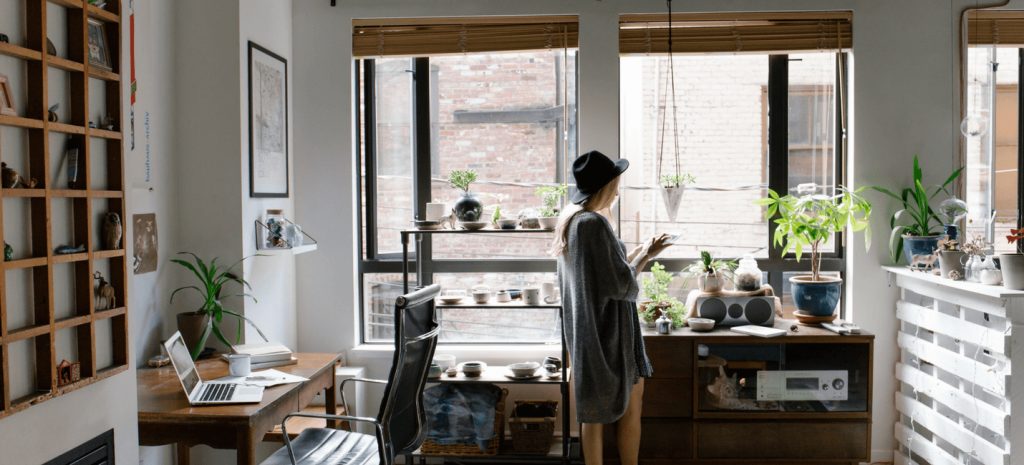
This is a guest contribution from ProBlogger Productivity Expert Nicole Avery.
It is the dream for many of us. Working from home, for our selves, working when we want, in our pyjamas if we want, until the reality of working from home kicks in. To work productively from home it requires discipline, planning and organization. Without them we can end up spending more hours working than we wanted to in a house that has become a shambles.
I have been working from home now for over five years now and I have moved from an ad hoc state where I felt like I was always working and if I wasn’t actually working I was still thinking or worrying about work, to a state where I happily switch off at night, relax and leave work until the next day.
It took me some time to find the balance that the freedom of working from home provides and putting in place some structure and boundaries so I could work productively at home. Here are five strategies I implemented to help me do this:
1. Set working hours
I think one of the most significant benefits for working from home is that in the most part, you can set the hours that you work; you can work early in the morning or late in the day depending on what you like. While you will read posts from morning advocates shouting the praises of getting up at 5am and working first thing in the morning to be most productive, I don’t think that is the case for everyone nor is it possible for everyone to work at that time.
I am a morning person, however the best time for me to fit exercise in is at 5.30am and after exercise my focus is on the kids until they are all off at school. My workday starts only after that. For others, they simply don’t work well in the mornings and science has shown when you are most productive does depend on your chronotype. Your chronotype is your natural master biological clock; think of it of how you are programmed to function across different times of the day. Setting your work hours at home to best match when you are most productive will save you hours of time. If you are interested in finding out your chronotype you can take a quiz here.
Setting work hours and sticking to them also helps eliminate productive procrastination that can so easily happen at home. There is always something you can be doing at home cleaning the bathroom, watering the garden, putting on a load of washing – all of which are tasks that need to be completed so you are not just lost in some Youtube abyss. But these tasks won’t be helping you to achieve your work goal. Having a time by which you need to start work whether like me it is 10am or 2pm if you work better in the afternoons, allows you to plan other times to do home tasks instead of in work time and you can keep some separation between the two.
2. Have a “finish work” routine
Whether your office is your coffee table or a fully kitted out home office, the fact remains that your work is still physically located where you are when you finish up for the day. This means the temptation to just do “one thing” after dinner can be exceptionally high and if you do that one thing; it can be a quick slippery slope to doing another hour of work before you have realized what has happened.
This can seem like a good idea and a way to keep on top of things, but not only is it not a productive way to work, it detrimentally affects your sleep and therefore your overall health. Study after study is now showing the impacts that blue light from devices has on us, including this one by a team at Harvard Medical School:
We found that the use of portable light-emitting devices immediately before bedtime has biological effects that may perpetuate sleep deficiency and disrupt circadian rhythms, both of which can have adverse impacts on performance, health, and safety.
When you finish work for the day, make it a definite finish. Create a routine that you follow each day, so it signals to yourself that you have finished. Have cues to allow your mind to switch off work and begin being present in what other activities you have on for the rest of the day.
The routine may start with writing your to do list for the next day. If you after tips on how to create a to do list that will set you up for a productive day see this post on Problogger – 5 Steps to Creating a Productive Blogging To Do List. Then have your “finish work” routine end with turning off your computer. I know some of you will say “but I will need the computer later for personal reasons”. This maybe the case but I would still highly recommend turning off the computer. It is a step that sets you up for success – you are much less likely to do just one thing, if that involves rebooting the computer, logging in and opening the application you need. It will help you to stay away from work once you have finished.
The reality is that if you need the computer for personal reasons in the evening, you can always turn it back on. If you leave it on just in case you need to use it, you are creating a temptation for yourself. You may be tempted while walking past the computer to check email and at some point you will need to turn it off which might expose you to a project you were working on and start your brain ticking over with ideas just before you go to bed!
3. Include breaks and movement
When we work for ourselves at home, we can be hard taskmasters. We will often work for hours without breaks, eat lunch at our desk and if we were to wear a step counter for the day we would see that we moved very little.
Quite obviously this way of working isn’t good for our overall health, but we often do it thinking we are being productive as we chalk up more hours of work each day. The data tells a different story though and it shows there is actually a negative correlation between hours worked and productivity. I shared the below graph in my post on How Working Fewer Hours Can Increase Your Productivity which shows the productivity (GDP per hour worked) in relation to the number of hours worked in OECD countries. The trend is clear: the more hours worked the less productive we are.

And if we are honest with ourselves we know this is true. By the time we are into our fourth hour of work with no break, the blog post that we could write in an hour first thing into our working day is now taking us twice as long. We get distracted and our mind wanders; sign that our mind needs a rest.
Making sure you take breaks regularly is key to staying productive and during the breaks if you really want to recharge, you need to move away from the computer. Stay off social media and email and allow your mind to rest. Walk around the house, sweep the floor, hang out washing to get you outside in the fresh air or even better take a quick 10 minute walk. You will be surprised how much better you will feel when you sit back down to work and how much more productively you will work.
4. Respect your time blocks
When you schedule your day, if you have followed my advice on batching, it will be broken into time blocks across the day. There will be time where you do your deep work of blog writing or product creation etc and there will time where you have scheduled your lighter work like social media and email etc.
Most of us choose to work from home as we want the flexibility it gives us, whether that be to attend activities at the kids’ school, catch up with friends or fit in other hobbies. But if we want to be productive and work towards our blogging goal, we need to use this flexibility while still respecting our time blocks.
As noted earlier I do my most productive and deep work earlier in the day, so when friends want to catch up, I will suggest an afternoon catch up so that I can still fit in my core work for the day. There will of course be occasions where I do take the morning off work to attend something which is time specific, but I will then reorganize the rest of my day or week to ensure the key work for the week, the most productive work for the week will be completed.
5. Manage the expectations of friends and family
I have found this to be the biggest challenge working from home, especially with the occupation of blogging. Most of my family and friends do not fully understand what I do and how “writing on the internet” pays my bills. Therefore they don’t realise how much popping in for a quick visit unannounced can impact my workday.
It has taken time and me summoning the courage to send texts saying no to visits, to help friends and family understand that dropping in during my work hours would be like them just popping into someone’s office in the CBD and expecting them to drop anything and go for a coffee. Of course that isn’t something they would do and therefore I need the same level of notice if they would like to get together for a catch up.
Working from home you need to learn the diplomatic art of saying no and protecting your work schedule. There may be times when it suits to catch up with someone unannounced or with short notice, but when we do this it can set the agenda for how friends and family interact with us, so we need to make sure it is sustainable.
What tips would you add to increase your productivity when working from home?
